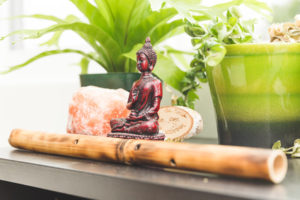 Seekers can conduct their daily spiritual practice anywhere, but you may want to consider creating a sacred space in your home or office which is specifically set aside for the purpose. Reading, journaling and meditating in the same location on a regular basis can make that place one which quite naturally evokes a sense of calm and quiet, and serves as an oasis of peace and stillness no matter how busy or hectic the rest of your life may be.
Seekers can conduct their daily spiritual practice anywhere, but you may want to consider creating a sacred space in your home or office which is specifically set aside for the purpose. Reading, journaling and meditating in the same location on a regular basis can make that place one which quite naturally evokes a sense of calm and quiet, and serves as an oasis of peace and stillness no matter how busy or hectic the rest of your life may be.
A sacred space can be as simple or elaborate as you want to make it, and should be created to accommodate the requirements of your own individual practice rather than any external idea of what is right or wrong. That said, there are several possible elements of a sacred space which you would do well to think about when establishing your own.
Silence and Solitude
Having previously discussed the importance of Silence and Solitude, it makes sense to try and locate your sacred space in a place which will be relatively free from interruptions. If you are fortunate enough to have a spare room which you can use for the purpose then by all means take advantage of that, but such extremes really aren’t possible or necessary for most people. It can be just as effective to set aside a quiet corner of a room, or even a quiet location outdoors if the climate permits it. The key in all cases is that your chosen space affords quiet and privacy at the times when you intend to practice.
Seating
You should next consider how you will sit for your daily spiritual practice, and make suitable arrangements. For example, if sitting meditation is a key part of your practice then you will probably want to equip your sacred space with a meditation cushion of some sort. Or, if your practice focuses more on spiritual reading and journaling, you may find that a standard armchair and a simple lap desk provide all the comfort you need.
Some might think that such considerations about proper seating are unnecessary, but if you want your daily spiritual practice to be something that you look forward to, it needs to be a fairly comfortable experience, and not one that causes physical aches and pains.
Altar
An altar is a structure which serves as a visual point of focus, and can be very useful in helping you to make the mental transition between daily life and your spiritual practice. It needn’t be a purpose-built structure, but could just as easily be a shelf or table in your chosen location. The important thing is that you should be able to view your altar when seated.
How you furnish your altar should, as always, reflect both your personal preferences and the needs of your own individual path. Items which are commonly used by Seekers include statues or images of spiritual figures (such as the Buddha, Jesus or Ganesh), potted plants or fresh flowers, singing bowls, candles and incense burners, but any other items which help you to turn your focus towards spiritual ideas and concepts can also be included.
Storage
A fourth component that you might like to consider is some kind of storage facility, which can be used to store spiritual texts, journals, mala beads and whatever other items you use in your daily practice. This storage facility could be a shelf or a carefully chosen box, but having all the things that you need for your daily practice in one specific place will make it easy for you to focus on what matters when you come to use your sacred space.
***
Creating a sacred space won’t prevent you from conducting your spiritual practice elsewhere from time to time by any means, but it will give you a clearly defined place that you can call your spiritual home. Spend time practicing there on a regular basis and its value will soon become apparent.

 Gratitude is a word which is normally used to describe a feeling of being grateful for something, but it can also be a powerful spiritual practice in its own right. In the former case, gratitude is a feeling that arises quite naturally when we find ourselves in a situation which we particularly appreciate. However, in the latter case, it is a feeling that is deliberately cultivated by taking time to focus on situations and conditions which are worthy of mindful appreciation.
Gratitude is a word which is normally used to describe a feeling of being grateful for something, but it can also be a powerful spiritual practice in its own right. In the former case, gratitude is a feeling that arises quite naturally when we find ourselves in a situation which we particularly appreciate. However, in the latter case, it is a feeling that is deliberately cultivated by taking time to focus on situations and conditions which are worthy of mindful appreciation. Spiritual journaling is the act of writing down spiritual observations, intentions, insights, experiences and progress on a regular basis. It is a practice which can be found in a great many traditions, but it will be particularly useful to you as a Seeker, because it can serve you in multiple ways: as a record of your spiritual development and growth in the past, as a point of focus for exploring the present, and as a source of inspiration for the future.
Spiritual journaling is the act of writing down spiritual observations, intentions, insights, experiences and progress on a regular basis. It is a practice which can be found in a great many traditions, but it will be particularly useful to you as a Seeker, because it can serve you in multiple ways: as a record of your spiritual development and growth in the past, as a point of focus for exploring the present, and as a source of inspiration for the future. Whilst you will find your own truth by looking within, it can also be very useful to explore the ideas and understandings of spiritual Seekers who have gone before you.
Whilst you will find your own truth by looking within, it can also be very useful to explore the ideas and understandings of spiritual Seekers who have gone before you. Creating your own spiritual path is all about learning to follow the guidance of your own intuition – that still, small voice within you which can be relied upon to lead you in exactly the right direction at exactly the right time. Before you can follow that inner voice, however, you first need to be able to hear it, and it is therefore no surprise that one of the key practices in almost all spiritual traditions is spending time in silence and solitude.
Creating your own spiritual path is all about learning to follow the guidance of your own intuition – that still, small voice within you which can be relied upon to lead you in exactly the right direction at exactly the right time. Before you can follow that inner voice, however, you first need to be able to hear it, and it is therefore no surprise that one of the key practices in almost all spiritual traditions is spending time in silence and solitude.